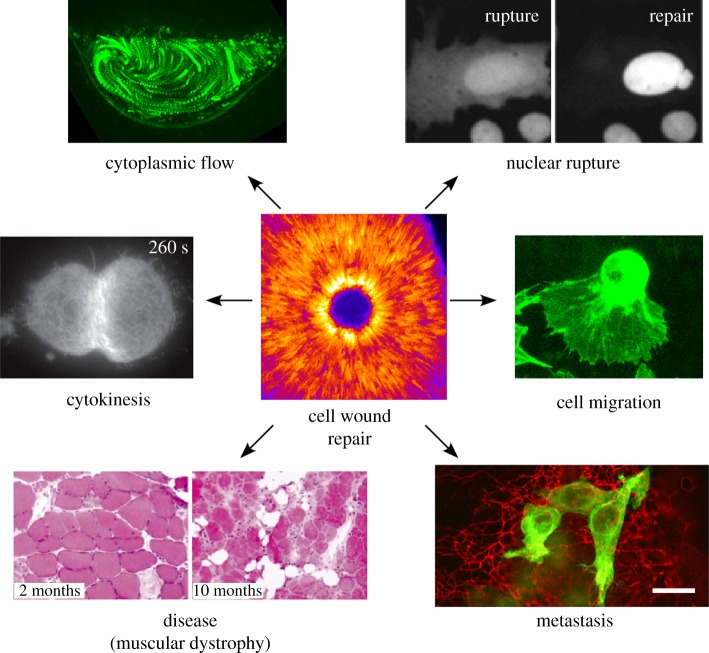Figure 5.
Beyond cellular repair. The study of single cell wound healing can inform many different fields of biology, from questions in basic science to the pathology of certain diseases. Cell Wound Repair: Single cell wound repair, shown here in a Drosophila embryo, requires the coordination of many cytoskeletal components, including spatio-temporal patterning of actin at the wound site. Image provided by M. Nakamura. Cytokinesis: Dividing cells require contraction of an actomyosin ring at the cell equator, shown here in human retinal cells undergoing cytokinesis. Adapted from fig. 4a in Spira et al.; Creative Commons license: https://creativecommons.org/licenses/by/4.0/ [114] (Copyright © 2017). Cytoplasmic flows: Cortical and cytoplasmic flows are responsible for bringing cellular components to sites where they are needed. During ooplasmic streaming in a developing Drosophila oocyte, cytoplasmic flows ensure that cellular content is evenly distributed. Image provided by J. Decker. Nuclear Rupture: Nuclei must faithfully repair after nuclear envelope rupture to preserve genomic integrity and this process may share protein components with cellular membrane repair. Nuclei from U2OS cells expressing GFP with a nuclear localization sequence undergoing nuclear rupture and repair. Adapted and republished with permission of The Rockefeller University Press, from Hatch & Hetzer; permission conveyed through Copyright Clearance Center, Inc. [115] (Copyright © 2016). Cell Migration: Cells, like this migratory haemocyte (macrophage) from a Drosophila larva, move throughout their environment by rapidly altering their cytoskeleton. Image provided by S. Parkhurst. Metastasis: Melanoma cells (green) spreading in a zebra fish larval hind-brain (red). In order for cells to invade new tissues, they must navigate a dense extracellular matrix while maintaining membrane integrity. Reprinted from Roh-Johnson et al., with permission from Elsevier [116] (Copyright © 2017). Disease: Skeletal muscle—a tissue that undergoes near constant wear and tear—from Dysferlin null mice, showing defective membrane repair in response to stress contributes to cell death. Adapted by permission from Springer Nature and Copyright Clearance Center: Bansal et al. [34] (Copyright © 2003).

